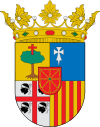Petilla de Aragón
| Petilla de Aragón | ||
|---|---|---|
| Municipality | ||
|
||
| Location in Spain | ||
| Coordinates: 42°27′41″N 1°5′34″W / 42.46139°N 1.09278°W | ||
| Country |
|
|
| Autonomous community |
|
|
| Province | Navarre | |
| Comarca | Comarca de Sangüesa | |
| Judicial district | Aoiz | |
| Government | ||
| • Mayor | Jorge Sedano (2007) (Paulino Rived Murillo) | |
| Area | ||
| • Total | 28 km2 (11 sq mi) | |
| Elevation | 843 m (2,766 ft) | |
| Population (2009) | ||
| • Total | 25 | |
| • Density | 0.89/km2 (2.3/sq mi) | |
| Demonym(s) | Petillés | |
| Time zone | CET (UTC+1) | |
| • Summer (DST) | CEST (UTC+2) | |
| Postal code | 50686 | |
Petilla de Aragón is a town and municipality of the autonomous community of Navarra, northern Spain. The municipality itself is formed by two enclaves (Petilla de Aragón itself and Los Bastanes) that are entirely surrounded by the neighboring autonomous community of Aragón.
The town was the birthplace of Nobel Prize-winning scientist Santiago Ramón y Cajal (1852–1934); Petilla terminology, a neurological nomenclature, is named after the town. Petilla was also the site of a real-life 15th century battle between the armies of the País Vasco and Aragón in which the fictional troubadour Manrico and the Conte di Luna, of Verdi's Il trovatore, fought on opposite sides, not knowing that they were brothers; this is recounted by the gipsy Azucena in her famous aria Stride la vampa!
Coordinates: 42°27′41″N 1°5′34″W / 42.46139°N 1.09278°W
...
Wikipedia


